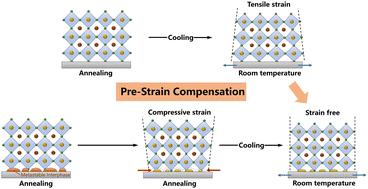当前位置:
X-MOL 学术
›
Energy Environ. Sci.
›
论文详情
Our official English website, www.x-mol.net, welcomes your
feedback! (Note: you will need to create a separate account there.)
Metastable interphase induced pre-strain compensation enables efficient and stable perovskite solar cells
Energy & Environmental Science ( IF 32.4 ) Pub Date : 2024-11-08 , DOI: 10.1039/d4ee03801k Hongyu Xu, Yun Xiao, Karim A. Elmestekawy, Pietro Caprioglio, Qiuyang Li, Qixuan Zhong, Yongqiang Ji, Tianyu Huang, Haoming Yan, Yingguo Yang, Laura M. Herz, Qihuang Gong, Henry J. Snaith, Rui Zhu, Lichen Zhao
Energy & Environmental Science ( IF 32.4 ) Pub Date : 2024-11-08 , DOI: 10.1039/d4ee03801k Hongyu Xu, Yun Xiao, Karim A. Elmestekawy, Pietro Caprioglio, Qiuyang Li, Qixuan Zhong, Yongqiang Ji, Tianyu Huang, Haoming Yan, Yingguo Yang, Laura M. Herz, Qihuang Gong, Henry J. Snaith, Rui Zhu, Lichen Zhao

|
High-efficiency metal halide perovskite solar cells (PSCs) include rigid substrates with low thermal-expansion coefficients (TECs), resulting in significant TEC mismatch with the perovskites with high TECs at the buried interface. This mismatch leads to thermally induced residual tensile strain in perovskite films after annealing during film fabrication, which facilitates ion migration and defect formation, thereby compromising the performance and stability of PSCs. In this study, we present a pre-strain compensation strategy by introducing an in situ generated metastable Pb(CH3NH2)2Cl2 (PMC) phase at the buried substrate/perovskite interface, which will transform into PbCl2 upon annealing of formamidinium lead iodide (FAPbI3)-based perovskite films. This phase transformation provides a source of compressive stress for the perovskite films to counteract the adverse residual tensile strain during cooling from annealing. This strategy is demonstrated to be able to effectively reduce the defect formation and non-radiative recombination rates in the perovskite films, while enhancing the charge-carrier mobility, lowering the exciton binding energy, and weakening the electron–phonon coupling interactions. As a result, the corresponding modified n–i–p PSCs achieve a champion efficiency of 25.83% (certified at 25.36%) and exhibit improved stability.
中文翻译:

亚稳态相间诱导预应变补偿可实现高效稳定的钙钛矿太阳能电池
高效金属卤化物钙钛矿太阳能电池 (PSC) 包括具有低热膨胀系数 (TEC) 的刚性衬底,导致与埋地界面处具有高 TEC 的钙钛矿发生显着的 TEC 失配。这种错配导致在薄膜制造过程中退火后钙钛矿薄膜中产生热诱导残余拉伸应变,从而促进离子迁移和缺陷形成,从而损害 PSC 的性能和稳定性。在这项研究中,我们通过在埋设衬底/钙钛矿界面处引入原位生成的亚稳态 Pb(CH3NH2)2Cl2 (PMC) 相来提出一种应变前补偿策略,该相将在碘化甲脒铅 (FAPbI3) 基钙钛矿薄膜。这种相变为钙钛矿薄膜提供了压应力源,以抵消退火冷却过程中不利的残余拉伸应变。该策略被证明能够有效降低钙钛矿薄膜中的缺陷形成和非辐射复合速率,同时增强电荷载流子迁移率,降低激子结合能,并削弱电子-声子耦合相互作用。因此,相应的修饰 n-i-p PSC 实现了 25.83% 的冠军效率(认证为 25.36%),并表现出更高的稳定性。
更新日期:2024-11-08
中文翻译:

亚稳态相间诱导预应变补偿可实现高效稳定的钙钛矿太阳能电池
高效金属卤化物钙钛矿太阳能电池 (PSC) 包括具有低热膨胀系数 (TEC) 的刚性衬底,导致与埋地界面处具有高 TEC 的钙钛矿发生显着的 TEC 失配。这种错配导致在薄膜制造过程中退火后钙钛矿薄膜中产生热诱导残余拉伸应变,从而促进离子迁移和缺陷形成,从而损害 PSC 的性能和稳定性。在这项研究中,我们通过在埋设衬底/钙钛矿界面处引入原位生成的亚稳态 Pb(CH3NH2)2Cl2 (PMC) 相来提出一种应变前补偿策略,该相将在碘化甲脒铅 (FAPbI3) 基钙钛矿薄膜。这种相变为钙钛矿薄膜提供了压应力源,以抵消退火冷却过程中不利的残余拉伸应变。该策略被证明能够有效降低钙钛矿薄膜中的缺陷形成和非辐射复合速率,同时增强电荷载流子迁移率,降低激子结合能,并削弱电子-声子耦合相互作用。因此,相应的修饰 n-i-p PSC 实现了 25.83% 的冠军效率(认证为 25.36%),并表现出更高的稳定性。


















































 京公网安备 11010802027423号
京公网安备 11010802027423号